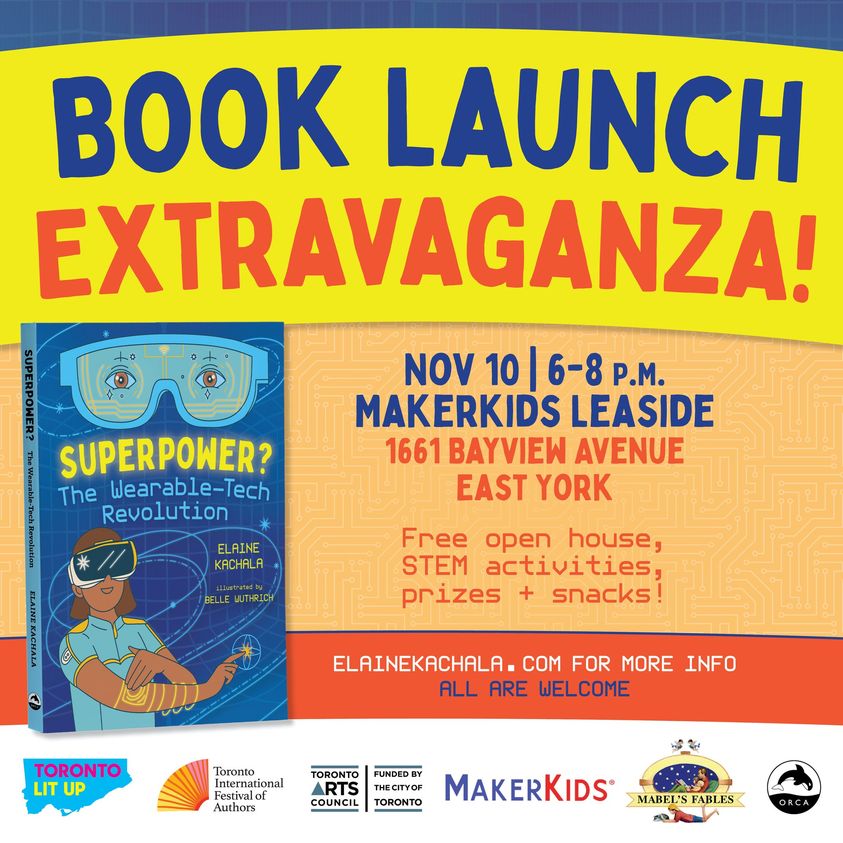
The Family Care Office asked author Elaine Kachala a few questions about Elaine’s first nonfiction book for middle readers: Superpower? The Wearable-Tech Revolution. Elaine is a U of T graduate. Superpower? The Wearable-Tech Revolution was released in October and will launch on November 10, 2022. Learn more about the launch and RSVP.
How did you come to write children’s books?
I worked as a health policy researcher, writer, and advisor for government and health agencies. Together with journalists and editorial teams, we’d talk about “our reports having legs” so they’d inspire people to make improvements in the healthcare system. Early on, we discovered the power of stories to explain complicated topics to governments and the public instead of just laying out the facts. It is satisfying and exciting to research a new topic, distill the information, and then write about it in a way that compels people to want to take action.
I’d never considered writing for kids, but I was looking for a creative outlet about six years ago. I love picture books; they’re brilliant pieces of art. Why not write a picture book? I revealed this goal to my family, and they bought me Anne Whitford Paul’s, A Hands-On Guide from Story Creation to Publication for Christmas. Many courses, conferences, and manuscript drafts later, I was at a workshop when I found myself discussing STEM/STEAM topics for middle readers. I’d started down the road of writing picture books, then, in one conversation, everything changed!
We talked about the impact of technology on people and the world and what would be the hook for this age group. I’m intrigued by STEM/STEAM topics because I have two daughters who work in these fields, and I’m always trying to understand their work. In my job at the time, I was learning about incredible wearable technologies underway to improve people’s lives, especially those with disabilities. But I didn’t want to write a book merely about technology; I was curious about the implications of technology. Suddenly, many threads came together, and this book was born!
When Kirstie Hudson at Orca Book Publishers said she wanted to publish Superpower? as part of Orca Think, a nonfiction series for middle-readers, I was thrilled beyond belief! I’m ever grateful to Kirstie and the Orca team for their unending enthusiasm and support. We signed in April 2020, and this book became my passion project.
Superpower? The Wearable-Tech Revolution is a non-fiction book. For what age range would you recommend the book?
The book is written for middle readers, ages 9-12 and grades 4-7. But I am hearing from parents and educators that they’re learning things too! They’re recommending the book for students of all ages and adults too!
Why do you write about STEM-related subjects? And for those of us who don’t know, what is STEAM?
The short answer is that the subjects fascinate me. But my interests aren’t purely about technology or science; they’re about how they cross over into social issues. This brings me to your question about STEAM. STEAM is an approach to learning that uses Science, Technology, Engineering, the Arts, and Mathematics to help students become critical thinkers and agile, creative problem solvers. The STEM to STEAM movement has been growing over the past years. The idea is that the needs of a competitive 21st-century economy require interdisciplinary minds.
When writing this book, I learned that one of the ways we design responsible technology is by working collaboratively in diverse and inclusive teams. Check out Chapter Five, called, How Do We Design Responsible Technology? SET UP! RISE UP! TEAM UP! I talk about different aspects of diversity and inclusion; STEAM is one of them.
I learned a fun fact: the STEM to STEAM movement began in the USA when John Maeda, former president of the Rhode Island School of Design, championed this movement with educational policymakers. Maeda had a fascinating career as a computer programmer and an artist. He knew first-hand about the limitations and the dangers when only techies created technology. He believed that advances in science and technology were critical for solving world problems, but these subjects alone would not be enough. Award-winning tech companies were innovative and successful because they hired people with art and design skills. Maeda said, “we want the products and services we buy and use to be made responsibly, presented honestly, and to come from the mind of a human being, not an algorithm.”[1]
Can you tell us about Sci/Why?
Sci/Why is a blog where “Canadian children’s writers discuss science, and the eternal question – why?” Several years ago, award-winning children’s author Claire Eamer had an idea: why not gather a group of like-minded writers and launch a blog to help parents, teachers, and librarians discover the wide world of Canadian science writing for kids? And so, it began! “Why?” Kids are always asking. So if you’re looking for great Canadian science books and writing resources, check out Sci/Why!
What did you study at UofT?
I studied psychology and sociology in my undergraduate work. I took a Sociology of Health and Illness course, which really hooked me and led me to a new career path. I’d worked as a medical technologist, made my way into hospital management, and considered doing a master’s in health care administration. But this sociology course started me thinking about the social, economic, and environmental issues that affect our health, well-being, and quality of life. So instead of pursuing an administration degree, I completed a master’s in environmental studies focusing on health promotion policy and planning. This led me to a fulfilling career working for government and health agencies. I’m ever grateful for that sociology course!
[1] Maeda, John. Why Stem Isn’t Enough to Train Tomorrow’s Creators, 2013. https://techonomy.com/stem-isnt-enough-train-tomorrows-creators/